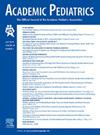Improving Delivery of Firearm Safety Resources for Behavioral Health Patients in the Pediatric Emergency Department: A Quality Improvement Initiative
IF 2.8
3区 医学
Q1 PEDIATRICS
引用次数: 0
Abstract
Objective
Addressing unsafe firearm storage is essential to preventing suicide and unintentional firearm injury. For patients presenting to our pediatric emergency department (ED) with behavioral health (BH) needs, we implemented a standardized approach to screening for exposure to unsafely stored firearms and offering firearm storage devices and educational resources to the families of patients presenting with BH concerns.
Methods
Using quality improvement methodology, we identified electronic medical record (EMR) documentation and availability of firearm safety resources (gun locks and firearm safety handouts) as areas for improvement. Plan-Do-Study-Act (PDSA) cycles were 1) integrating standardized, templated firearm safety questions within an existing social work BH assessment template in the EMR; and 2) improving access to/restocking of firearm safety resources. We tracked screening documentation rates and safety resource offering rates as process and outcome measures.
Results
Screening documentation rates increased from 0% preintervention to an initial 89% postintroduction of standardized EMR firearm safety questions. Firearm safety screening documentation rates increased to and were sustained at >90% without special cause variation following our 2 PDSA cycles. Two sporadic and expected fluctuations occurred, both attributed to changes in screening documentation formatting in EMR. Over the course of the study, our offering rate increased from 0% prestudy to 85% for patients with unsafely stored guns following chart review.
Conclusions
Incorporating firearm safety questions into the EMR and maintaining a supply of firearm safety resources in the ED is an effective and sustainable approach to enhancing firearm safety for high-risk BH patients.
改善儿科急诊科行为健康患者的枪支安全资源交付:一项质量改进倡议。
目的:解决不安全枪支储存问题对预防自杀和意外枪支伤害至关重要。对于在儿科急诊科(ED)就诊的有行为健康(BH)需求的患者,我们实施了一种标准化的方法来筛查是否接触过不安全储存的枪支,并为有行为健康问题的患者的家属提供枪支储存设备和教育资源。方法:使用质量改进方法,我们确定了电子病历(EMR)文件和枪支安全资源(枪支锁和枪支安全讲义)的可用性作为改进的领域。PDSA循环是:1)在EMR中现有的社会工作BH评估模板中整合标准化的、模板化的枪支安全问题;2)改善枪支安全资源的获取/补充。我们跟踪了筛选文件率和安全资源提供率作为过程和结果度量。结果:筛查记录率从干预前的0%增加到引入标准化EMR枪支安全问题后的89%。在我们的两次PDSA循环之后,枪支安全筛查文件率增加到并保持在90%左右,没有特殊原因的变化。发生了两次偶发和预期的波动,均归因于电子病历中筛查文件格式的变化。在研究过程中,我们的提供率从研究前的0%增加到85%,这些患者的枪支储存不安全。结论:将枪支安全问题纳入EMR,并在急诊科保持枪支安全资源的供应,是提高高危BH患者枪支安全的有效和可持续的方法。
本文章由计算机程序翻译,如有差异,请以英文原文为准。
求助全文
约1分钟内获得全文
求助全文
来源期刊

Academic Pediatrics
PEDIATRICS-
CiteScore
4.60
自引率
12.90%
发文量
300
审稿时长
60 days
期刊介绍:
Academic Pediatrics, the official journal of the Academic Pediatric Association, is a peer-reviewed publication whose purpose is to strengthen the research and educational base of academic general pediatrics. The journal provides leadership in pediatric education, research, patient care and advocacy. Content areas include pediatric education, emergency medicine, injury, abuse, behavioral pediatrics, holistic medicine, child health services and health policy,and the environment. The journal provides an active forum for the presentation of pediatric educational research in diverse settings, involving medical students, residents, fellows, and practicing professionals. The journal also emphasizes important research relating to the quality of child health care, health care policy, and the organization of child health services. It also includes systematic reviews of primary care interventions and important methodologic papers to aid research in child health and education.
 求助内容:
求助内容: 应助结果提醒方式:
应助结果提醒方式:


